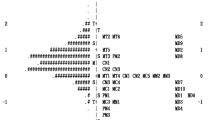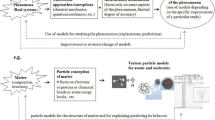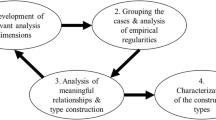Abstract
Understanding scientific models and practicing scientific modeling have been emphasized and advocated in science learning. Although teachers have been perceived as shaping their students’ understanding of the nature of science, they have been recognized for their lack of understanding of scientific models. This study explores middle school science teachers’ and ninth-grade students’ performance in terms of their understanding of scientific models and their construction and evaluation of these models. The study participants comprised 95 science teachers and 608 ninth-grade students. To investigate the students’ understanding of scientific models, they were asked to fill out a Students’ Understanding of Models in Science survey. To explore the students’ model construction and evaluation, they were asked to explain three different magnetic phenomena and to provide the criteria they used to evaluate the scientific models. The results show that the teachers’ performance on these three aspects was significantly better than that of the students. However, this study indicated that teachers have similar problems as students in terms of understanding theoretical representations of scientific models and practicing model construction. Moreover, those teachers who had a better understanding that scientific models are not the replica of target events could develop higher levels of models while students with more understanding that scientific models are the replica of target events were able to develop higher levels of models. The findings of the study contribute to a better understanding of the gap between teachers and students, which will be crucial for designing a better modeling-based curriculum.
Similar content being viewed by others
References
Bayir, E., Cakici, Y., & Ertas, O. (2014). Exploring natural and social scientists’ views of nature of science. International Journal of Science Education, 36(8), 1286–1312.
Chang, H. Y., & Chang, H. C. (2013). Scaffolding students’ online critiquing of expert-and peer-generated molecular models of chemical reactions. International Journal of Science Education, 35(12), 2028–2056.
Cheng, M. F., & Brown, D. E. (2010). Conceptual resources in self-developed explanatory models: The importance of integrating conscious and intuitive knowledge. International Journal of Science Education, 32(17), 2367–2392.
Cheng, M. F., Lin, J. L, Chang, Y. C., Li, H. W., Wu, T. Y., & Lin, D.-M. (2014). Developing explanatory models of magnetic phenomena through modelbased inquiry. Journal of Baltic Science Education, 13(3), 351–360.
Cheng, M. F., & Brown, D. E. (2015). The role of scientific modeling criteria in advancing students’explanatory ideas of magnetism. Journal of Research in Science Teaching, 52(8), 1053–1081.
Cheng, M. F., & Lin, J. L. (2015). Investigating the Relationship between Students’Views of Scientific Models and Their Development of Models. International Journal of Science Education, 37(15), 2453–2475.
Cheng, M. F., Lin, J. L., Lin, S. Y., & Cheng, C. H. (2017). Scaffolding middle school and high school students’modeling processes. Journal of Baltic Science Education, 16(2), 207–217.
Chinn, C. A., & Brewer, W. F. (2001). Models of data: a theory of how people evaluate data. Cognition and Instruction, 19(3), 323–393.
Chinn, C. A., Pluta, W. J., Buckland, L. A., Rogat, T. K., Difranco, J., & Witham, S. (2010). Promoting reasoning: a microgenetic study of middle-school students learning through model-based inquiry. Symposium presented at the annual meeting of the American Educational Research Association, Denver, CO.
Cohen, J. (1988). Statistical power analysis for the behavioral sciences. Hillsdale, NJ: Erlbaum.
Danusso, L., Testa, I., & Vicentini, M. (2010). Improving prospective teachers’ knowledge about scientific models and modelling: design and evaluation of a teacher education intervention. International Journal of Science Education, 32(7), 871–905.
Davis, E. A., Kenyon, L., Hug, B., Nelson, M., Beyer, C., Schwarz, C., & Reiser, B. (2008). MoDeLS: designing supports for teachers using scientific modeling. Paper presented at the annual meeting of the Association for Science Teacher Education, St. Louis, MO.
Giere, R. (1988). Laws, theories, and generalizations. In A. Grünbaum & W. Salmon (Eds.), The limitations of deductivism (pp. 37–46). Berkeley: University of California Press.
Gilbert, J. K. (2008). Visualization: an emergent field of practice and enquiry in science education. In J. K. Gilbert, M. Reiner, & M. Nakhlel (Eds.), Visualization: theory and practice in science education (pp. 3–24). New York, NY: Springer.
Gilbert, J. K., & Boulter, C. J. (1998). Learning science through models and modeling. In B. J. Fraser & K. G. Tobin (Eds.), International handbook of science education (pp. 53–66). Dordrecht, the Netherlands: Kluwer academic.
Gilbert, J. K., & Justi, R. (2016). Modelling-based teaching in science education. Basel, Switzerland: Springer.
Gobert, J., O’Dwyer, L., Horwitz, P., Buckley, B., Levy, S., & Wilensky, U. (2011). Examining the relationship between students’ understanding of the nature of models and conceptual learning in biology, physics, and chemistry. International Journal of Science Education, 33(5), 653–684.
Gogolin, S., & Krüger, D. (2018). Students’ understanding of the nature and purpose of models. Journal of Research in Science Teaching, 55(9), 1313–1338.
Gouvea, J., & Passmore, C. (2017). ‘Models of’ versus ‘models for’. Science & Education, 26(1–2), 49–63.
Grosslight, L., Unger, C., Jay, E., & Smith, C. L. (1991). Understanding models and their use in science: conceptions of middle and high school students and experts. Journal of Research in Science Teaching, 28(9), 799–822.
Grünkorn, J., Upmeier zu Belzen, A., & Krüger, D. (2014). Assessing students’ understandings of biological models and their use in science to evaluate a theoretical framework. International Journal of Science Education, 36(10), 1651–1684.
Guisasola, J., Almudi, J. M., & Zubimendi, J. L. (2004). Difficulties in learning the introductory magnetic field theory in the first years of university. Science Education, 88(3), 443–464.
Harrison, A. G., & Treagust, D. F. (2000). A typology of school science models. International Journal of Science Education, 22(9), 1011–1026.
Henze, I., Van Driel, J., & Verloop, N. (2007). The change of science teachers’ personal knowledge about teaching models and modelling in the context of science education reform. International Journal of Science Education, 29(15), 1819–1846.
Justi, R. S., & Gilbert, J. K. (2002). Science teachers’ knowledge about and attitudes towards the use of models and modelling in learning science. International Journal of Science Education, 24(12), 1273–1292.
Kang, S., Scharmann, L. C., & Noh, T. (2005). Examining students’ views on the nature of science: results from Korean 6th, 8th, and 10th graders. Science Education, 89(2), 314–334.
Krell, M., & Krüger, D. (2016). Testing models: a key aspect to promote teaching activities related to models and modelling in biology lessons. Journal of Biological Education, 50(2), 160–173.
Krell, M., Upmeier zu Belzen, A., & Krüger, D. (2012). Students’ understanding of the purpose of models in different biological contexts. International Journal of Biology Education, 2(2), 1–34.
Krell, M., Upmeier zu Belzen, A., & Krüger, D. (2014). Students’ levels of understanding models and modelling in biology: global or aspect-dependent? Research in Science Education, 44(1), 109–132.
Krell, M., Reinisch, B., & Krüger, D. (2015). Analyzing students’ understanding of models and modeling referring to the disciplines biology, chemistry, and physics. Research in Science Education, 45(3), 367–393.
Kuhn, T. S. (1977). The essential tension. Chicago, IL: University of Chicago Press.
Lin, J.-W. (2014). Elementary school teachers’ knowledge of model functions and modeling processes: a comparison of science and non-science majors. International Journal of Science and Mathematics Education, 12(5), 1197–1220.
Louca, T. L., & Zacharia, C. Z. (2012). Modeling-based learning in science education: cognitive, metacognitive, social, material and epistemological contributions. Educational Review, 64(4), 471–492.
Mahr, B. (2011). On the epistemology of models. In G. Abel & J. Conant (Eds.), Rethinking epistemology (pp. 301–352). Berlin: De Gruyter.
Mayr, E. (1982). The growth of biological thought: diversity, evolution, and inheritance. Cambridge, MA: Harvard University Press.
Mendonça, P. C. C., & Justi, R. (2014). An instrument for analyzing arguments produced in modeling-based chemistry lessons. Journal of Research in Science Teaching, 51(2), 192–218.
Ministry of Education in Taiwan. (2016). K-12 science education curriculum guideline. Taipei: Ministry of Education in Taiwan.
National Research Council. (2007). Taking science to school: learning and teaching science in grades K–8. Washington, DC: National Academies Press.
National Research Council. (2012). A framework for K–12 science education: practices, crosscutting concepts, and core ideas. Washington, DC: National Academies Press.
Next Generation Science Standards Lead States. (2013). Next generation science standards: for states, by states. Washington, DC: Achieve.
Nicolaou, C., & Constantinou, C. (2014). Assessment of the modeling competence: a systematic review and synthesis of empirical research. Educational Research Review, 13, 52–73.
Oh, P. S., & Oh, S. J. (2011). What teachers of science need to know about models: an overview. International Journal of Science Education, 33(8), 1109–1130.
Park, S.-K. (2013). The relationship between students’ perception of the scientific models and their alternative conceptions of the lunar phases. Eurasia Journal of Mathematics, Science & Technology Education, 9(3), 285–299.
Passmore, C., Gouvea, J. S., & Giere, R. (2014). Models in science and in learning science: focusing scientific practice on sense-making. In M. R. Matthews (Ed.), International handbook of research in history, philosophy and science teaching (pp. 1171–1202). Dordrecht: Springer.
Pluta, W. J., Chinn, C. A., & Duncan, R. G. (2011). Learners’ epistemic criteria for good scientific models. Journal of Research in Science Teaching, 48(5), 486–511.
Schwartz, R., & Lederman, N. (2008). What scientists say: scientists’ views of nature of science and relation to science context. International Journal of Science Education, 30(6), 727–771.
Schwarz, C. V., & White, B. Y. (2005). Metamodeling knowledge: developing students’ understanding of scientific modeling. Cognition and Instruction, 23(2), 165–205.
Schwarz, C. V., Reiser, B. J., Davis, E. A., Kenyon, L., Acher, A., Fortus, D., et al. (2009). Developing a learning progression for scientific modeling: making scientific modeling accessible and meaningful for learners. Journal of Research in Science Teaching, 46(6), 632–654.
Schwarz, C. V., Reiser, B., Acher, A., Kenyon, L., & Fortus, D. (2012). MoDeLS: challenges in defining a learning progression for scientific modeling. In A. Alonzo & A. Gotwals (Eds.), Learning progressions in science: current challenges and future directions (pp. 101–137). Boston, MA: Sense.
Sins, P. H., Savelsbergh, E. R., van Joolingen, W. R., & van Hout-Wolters, B. H. (2009). The relation between students’ epistemological understanding of computer models and their cognitive processing on a modelling task. International Journal of Science Education, 31(9), 1205–1229.
Snir, J., Smith, C. L., & Raz, G. (2003). Linking phenomena with competing underlying models: a software tool for introducing students to the particulate model of matter. Science Education, 87(6), 794–830.
Taber, K. S. (2013). Modelling learners and learning in science education: developing representations of concepts, conceptual structure and conceptual change to inform teaching and research. Dordrecht, the Netherlands: Springer.
Treagust, D. F., Chittleborough, G., & Mamiala, T. L. (2002). Students’ understanding of the role of scientific models in learning science. International Journal of Science Education, 24(4), 357–368.
Van Der Valk, T., Van Driel, J. H., & De Vos, W. (2007). Common characteristics of models in present-day scientific practice. Research in Science Education, 37(4), 469–488.
Van Driel, J. H., & Verloop, N. (1999). Teachers’ knowledge of models and modelling in science. International Journal of Science Education, 21(11), 1141–1153.
Van Driel, J. H., & Verloop, N. (2002). Experienced teachers’ knowledge of teaching and learning of models and modelling in science education. International Journal of Science Education, 24(12), 1255–1272.
Voutsina, L., & Ravanis, K. (2012). History of physics and conceptual constructions: the case of magnetism. Themes in Science and Technology Education, 4(1), 1–20.
Windschitl, M., & Thompson, J. (2006). Transcending simple forms of school science investigation: the impact of preservice instruction on teachers’ understandings of model-based inquiry. American Educational Research Journal, 43(4), 783–835.
Author information
Authors and Affiliations
Corresponding author
Additional information
Publisher’s Note
Springer Nature remains neutral with regard to jurisdictional claims in published maps and institutional affiliations.
Rights and permissions
About this article
Cite this article
Cheng, MF., Wu, TY. & Lin, SF. Investigating the Relationship Between Views of Scientific Models and Modeling Practice. Res Sci Educ 51 (Suppl 1), 307–323 (2021). https://doi.org/10.1007/s11165-019-09880-2
Published:
Issue Date:
DOI: https://doi.org/10.1007/s11165-019-09880-2




